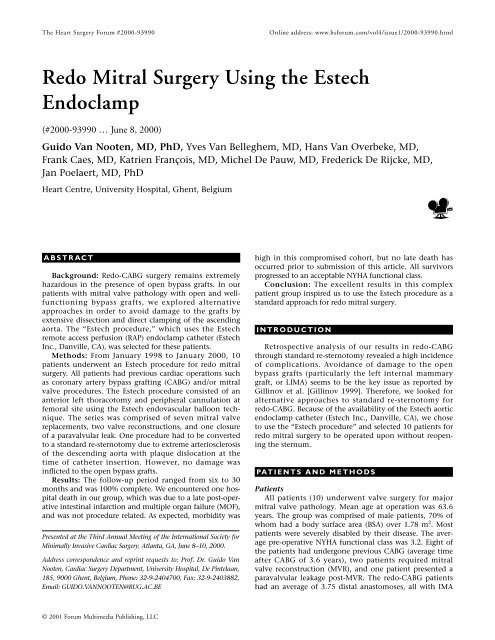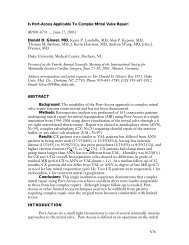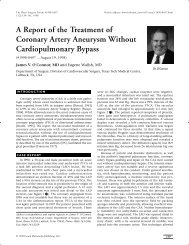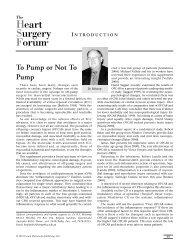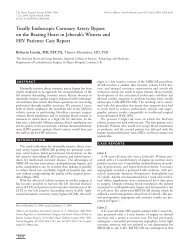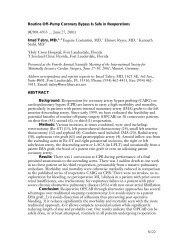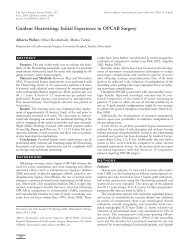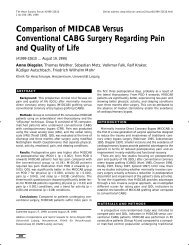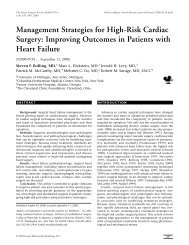Redo Mitral Surgery Using the Estech Endoclamp
Redo Mitral Surgery Using the Estech Endoclamp
Redo Mitral Surgery Using the Estech Endoclamp
Create successful ePaper yourself
Turn your PDF publications into a flip-book with our unique Google optimized e-Paper software.
The Heart <strong>Surgery</strong> Forum #2000-93990<br />
<strong>Redo</strong> <strong>Mitral</strong> <strong>Surgery</strong> <strong>Using</strong> <strong>the</strong> <strong>Estech</strong><br />
<strong>Endoclamp</strong><br />
(#2000-93990 … June 8, 2000)<br />
Guido Van Nooten, MD, PhD, Yves Van Belleghem, MD, Hans Van Overbeke, MD,<br />
Frank Caes, MD, Katrien François, MD, Michel De Pauw, MD, Frederick De Rijcke, MD,<br />
Jan Poelaert, MD, PhD<br />
Heart Centre, University Hospital, Ghent, Belgium<br />
ABSTRACT<br />
Background: <strong>Redo</strong>-CABG surgery remains extremely<br />
hazardous in <strong>the</strong> presence of open bypass grafts. In our<br />
patients with mitral valve pathology with open and wellfunctioning<br />
bypass grafts, we explored alternative<br />
approaches in order to avoid damage to <strong>the</strong> grafts by<br />
extensive dissection and direct clamping of <strong>the</strong> ascending<br />
aorta. The “<strong>Estech</strong> procedure,” which uses <strong>the</strong> <strong>Estech</strong><br />
remote access perfusion (RAP) endoclamp ca<strong>the</strong>ter (<strong>Estech</strong><br />
Inc., Danville, CA), was selected for <strong>the</strong>se patients.<br />
Methods: From January 1998 to January 2000, 10<br />
patients underwent an <strong>Estech</strong> procedure for redo mitral<br />
surgery. All patients had previous cardiac operations such<br />
as coronary artery bypass grafting (CABG) and/or mitral<br />
valve procedures. The <strong>Estech</strong> procedure consisted of an<br />
anterior left thoracotomy and peripheral cannulation at<br />
femoral site using <strong>the</strong> <strong>Estech</strong> endovascular balloon technique.<br />
The series was comprised of seven mitral valve<br />
replacements, two valve reconstructions, and one closure<br />
of a paravalvular leak. One procedure had to be converted<br />
to a standard re-sternotomy due to extreme arteriosclerosis<br />
of <strong>the</strong> descending aorta with plaque dislocation at <strong>the</strong><br />
time of ca<strong>the</strong>ter insertion. However, no damage was<br />
inflicted to <strong>the</strong> open bypass grafts.<br />
Results: The follow-up period ranged from six to 30<br />
months and was 100% complete. We encountered one hospital<br />
death in our group, which was due to a late post-operative<br />
intestinal infarction and multiple organ failure (MOF),<br />
and was not procedure related. As expected, morbidity was<br />
Presented at <strong>the</strong> Third Annual Meeting of <strong>the</strong> International Society for<br />
Minimally Invasive Cardiac <strong>Surgery</strong>, Atlanta, GA, June 8–10, 2000.<br />
Address correspondence and reprint requests to: Prof. Dr. Guido Van<br />
Nooten, Cardiac <strong>Surgery</strong> Department, University Hospital, De Pintelaan,<br />
185, 9000 Ghent, Belgium, Phone: 32-9-2404700, Fax: 32-9-2403882,<br />
Email: GUIDO.VANNOOTEN@RUG.AC.BE<br />
© 2001 Forum Multimedia Publishing, LLC<br />
Online address: www.hsforum.com/vol4/issue1/2000-93990.html<br />
high in this compromised cohort, but no late death has<br />
occurred prior to submission of this article. All survivors<br />
progressed to an acceptable NYHA functional class.<br />
Conclusion: The excellent results in this complex<br />
patient group inspired us to use <strong>the</strong> <strong>Estech</strong> procedure as a<br />
standard approach for redo mitral surgery.<br />
INTRODUCTION<br />
Retrospective analysis of our results in redo-CABG<br />
through standard re-sternotomy revealed a high incidence<br />
of complications. Avoidance of damage to <strong>the</strong> open<br />
bypass grafts (particularly <strong>the</strong> left internal mammary<br />
graft, or LIMA) seems to be <strong>the</strong> key issue as reported by<br />
Gillinov et al. [Gillinov 1999]. Therefore, we looked for<br />
alternative approaches to standard re-sternotomy for<br />
redo-CABG. Because of <strong>the</strong> availability of <strong>the</strong> <strong>Estech</strong> aortic<br />
endoclamp ca<strong>the</strong>ter (<strong>Estech</strong> Inc., Danville, CA), we chose<br />
to use <strong>the</strong> “<strong>Estech</strong> procedure” and selected 10 patients for<br />
redo mitral surgery to be operated upon without reopening<br />
<strong>the</strong> sternum.<br />
PATIENTS AND METHODS<br />
Patients<br />
All patients (10) underwent valve surgery for major<br />
mitral valve pathology. Mean age at operation was 63.6<br />
years. The group was comprised of male patients, 70% of<br />
whom had a body surface area (BSA) over 1.78 m 2 . Most<br />
patients were severely disabled by <strong>the</strong>ir disease. The average<br />
pre-operative NYHA functional class was 3.2. Eight of<br />
<strong>the</strong> patients had undergone previous CABG (average time<br />
after CABG of 3.6 years), two patients required mitral<br />
valve reconstruction (MVR), and one patient presented a<br />
paravalvular leakage post-MVR. The redo-CABG patients<br />
had an average of 3.75 distal anastomoses, all with IMA
The Heart <strong>Surgery</strong> Forum #2000-93990<br />
graft, and all open at <strong>the</strong> time of operation. Venous grafts<br />
presented a patency of 87%. All patients (except one with<br />
a major paravalvular leak after mitral valve replacement)<br />
presented major mitral valve regurgitation (4/4 on<br />
echocardiograph). The implanting surgeon chose <strong>the</strong> procedure<br />
after consulting with <strong>the</strong> patient and obtaining <strong>the</strong><br />
patient’s verbal informed consent.<br />
Operative Technique<br />
Left anterior thoracotomy was performed in <strong>the</strong> fourth<br />
intercostal space (length = 12 to 22 cm). The left atrium<br />
was opened in <strong>the</strong> inter-atrial groove posterior to <strong>the</strong><br />
phrenic nerve. Meanwhile, peripheral cardiopulmonary<br />
bypass was installed at <strong>the</strong> left inguinal level in all cases.<br />
The <strong>Estech</strong> femoral 21 Fr aortic balloon ca<strong>the</strong>ter was guided<br />
into <strong>the</strong> ascending aorta under echocardiographic control<br />
and placed within approximately 2.5 cm of <strong>the</strong> aortic<br />
valve. Adequate venous drainage was obtained by means<br />
of a 32 or 36 Fr femoral cannula in addition to a 28 or 32<br />
Fr direct atrial cannulation through <strong>the</strong> thoracotomy.<br />
Myocardial protection was accomplished with moderate<br />
systemic hypo<strong>the</strong>rmia (25° to 28°C), and anterograde crystalloid<br />
modified St. Thomas cardioplegia was delivered at<br />
<strong>the</strong> tip of <strong>the</strong> ca<strong>the</strong>ter after complete inflation of <strong>the</strong><br />
endoclamp. Echocardiography by a multiplane Sonos 2500<br />
(Hewlett-Packard Inc., Andover, MA) transesophageal<br />
probe and direct pressure monitoring controlled <strong>the</strong> procedure.<br />
The same group of surgeons using identical operative<br />
techniques performed all operations. For mitral valve<br />
replacement, <strong>the</strong> interrupted insertion technique was<br />
used, with preservation of <strong>the</strong> native valve apparatus<br />
where possible. Visualization of <strong>the</strong> mitral valve was assisted<br />
by endoscopy [Chitwood 1997].<br />
Procedures<br />
We performed seven mitral valve replacements (six<br />
mechanical and one biological pros<strong>the</strong>sis), two radical<br />
mitral valve reconstructions (MVPs) and one closure of a<br />
partial dehiscence of <strong>the</strong> pros<strong>the</strong>sis for paravalvular leakage.<br />
Associated procedures in <strong>the</strong> MVP group included<br />
mitral valve annuloplasty (two patients). <strong>Endoclamp</strong>ing<br />
was performed by introduction of 25 to 37 cc of saline<br />
solution into <strong>the</strong> balloon. Cardiac arrest was obtained by<br />
means of 1000 cc modified St. Thomas cardioplegia delivered<br />
at <strong>the</strong> tip of <strong>the</strong> ca<strong>the</strong>ter. However, because <strong>the</strong> LIMA<br />
graft was not clamped, cardiac activity restarted prematurely.<br />
Thus, fur<strong>the</strong>r myocardial protection was provided<br />
at moderate hypo<strong>the</strong>rmia of 25°C by additional doses of<br />
cardioplegia every 15 minutes. Mean aortic clamp-time<br />
was 52.6 min. (standard 46.6 min., p = ns) for MVR and<br />
74.8 min. (standard 66.1 min.) for MVP. De-airing<br />
remained a major problem because of inaccessibility of <strong>the</strong><br />
ventricles and could only be achieved by suction at <strong>the</strong> tip<br />
of <strong>the</strong> endoclamp. Mean ECC-time of 96.7 min. (standard<br />
77 min., p = 0.001) for MVR was prolonged due to longer<br />
reperfusion times before obtaining stable hemodynamics.<br />
However, only one patient was in need of postoperative<br />
inotropic support.<br />
RESULTS<br />
Mortality and Morbidity<br />
One hospital death, which was non-procedure related,<br />
occurred. The death took place after late postoperative<br />
intestinal infarction (61 days post-op) and subsequent<br />
multiple organ failure (MOF). No late deaths have<br />
occurred prior to submission of this article.<br />
One arteriosclerotic patient had to be converted to a<br />
standard re-sternotomy due to <strong>the</strong> dislocation of a plaque<br />
in an extremely calcified descending aorta while positioning<br />
<strong>the</strong> endoclamp (see Figure 1, ). One patient required<br />
intra-aortic balloon pumping for post-operative low cardiac<br />
output, and was successfully weaned six days following<br />
initial operation. One patient experienced a postoperative<br />
non-Q-wave myocardial infarction, although all<br />
bypass grafts were patent on angiographic control. One<br />
patient with significant vascular history experienced cardiovascular<br />
accident (CVA) in <strong>the</strong> early postoperative<br />
course but had complete neurological recuperation.<br />
Ano<strong>the</strong>r patient was reoperated for bleeding.<br />
Follow-up<br />
Follow-up ranged from six to 30 months and was 100%<br />
complete, yielding 16 patient/years. All hospital survivors,<br />
even some who were severely disabled pre-operatively,<br />
progressed to NYHA functional class 1 or 2 (average 1.2).<br />
Seventy percent of <strong>the</strong> patients were followed entirely at<br />
our institution. Patients were questioned at seven weeks,<br />
six months, and each year following discharge. Questions<br />
were presented by staff members before clinical examination<br />
and addressed general health, medication, and complications.<br />
The remaining 30% of patients were followed<br />
by <strong>the</strong>ir referring cardiologist and/or physician, who submitted<br />
information by mail, fax or telephone. No episodes<br />
of endocarditis, hemolysis, or paravalvular leakage have<br />
occurred as of this date. During follow-up, echocardiographic<br />
control was provided in-house or by outside cardiologists<br />
for <strong>the</strong> first week and every six months <strong>the</strong>reafter,<br />
confirming <strong>the</strong> absence of mitral valve regurgitation with<br />
full recovery of <strong>the</strong> left ventricular function.<br />
DISCUSSION<br />
The early results of this difficult redo mitral valve<br />
group, even for patients who were severely disabled preoperatively,<br />
are better than <strong>the</strong> results we have obtained<br />
by standard re-operation techniques in our institution<br />
since 1990. Avoidance of damage to <strong>the</strong> open bypass grafts<br />
during re-sternotomy seems crucial, as reported by o<strong>the</strong>r<br />
authors [Gillinov 1999]. Although not a thorough portaccess<br />
operation as <strong>the</strong> operation described by Mohr et al.,<br />
an alternative approach was explored by <strong>the</strong> authors for<br />
mitral valve surgery post-CABG [Mohr 1998]. The <strong>Estech</strong><br />
procedure with <strong>the</strong> aortic endoclamp, allowed us to operate<br />
successfully on 10 mitral patients without reopening<br />
<strong>the</strong> sternum. Our group was comprised of male patients, a
striking 70% of whom had a BSA over 1.78 m 2 . This size<br />
feature is due to <strong>the</strong> technique requiring larger femoral<br />
arteries (and thus larger patients) for easy cannulation.<br />
Although <strong>the</strong> procedure is feasible in arteriosclerotic<br />
patients, one patient had to be converted to a standard resternotomy<br />
due to a plaque dislocation in an extremely<br />
calcified descending aorta. Precise positioning of <strong>the</strong><br />
ca<strong>the</strong>ter is critical. Once <strong>the</strong> balloon was positioned at <strong>the</strong><br />
correct level in <strong>the</strong> ascending aorta, endoclamping was<br />
easily performed by introducing saline solution into <strong>the</strong><br />
balloon. As previously described, cardiac arrest was<br />
obtained by means of anterograde cardioplegia delivered<br />
at <strong>the</strong> tip of <strong>the</strong> ca<strong>the</strong>ter. However, because <strong>the</strong> LIMA graft<br />
was not clamped, myocardial protection was sub-optimal,<br />
necessitating additional doses of cardioplegia and deeper<br />
cooling. A direct balloon endoclamping of <strong>the</strong> subclavian<br />
or internal mammary artery could be useful in this respect.<br />
CONCLUSION<br />
The mean aortic clamp-times for <strong>the</strong> <strong>Estech</strong> procedure<br />
were comparable to those of standard procedures. However,<br />
de-airing remained a major problem because of inaccessibility<br />
of <strong>the</strong> ventricles and could only be obtained by suc-<br />
© 2001 Forum Multimedia Publishing, LLC<br />
<strong>Redo</strong> <strong>Mitral</strong> <strong>Surgery</strong> <strong>Using</strong> <strong>the</strong> <strong>Estech</strong> <strong>Endoclamp</strong>—Van Nooten et al.<br />
tion at <strong>the</strong> tip of <strong>the</strong> ca<strong>the</strong>ter. Mean ECC-time was probably<br />
prolonged due to initial hemodynamic instability during<br />
reperfusion. Despite this, only one patient was in need<br />
of postoperative inotropic support. Left ventricular function<br />
was fully recovered, with a significant reduction of <strong>the</strong><br />
postoperative left ventricular end-diastolic diameter over<br />
time. Moreover, all survivors progressed considerably in<br />
NYHA functional class, but fur<strong>the</strong>r follow-up is needed.<br />
The excellent results in this complex patient group inspired<br />
us to use <strong>the</strong> <strong>Estech</strong> procedure, despite its technical difficulties,<br />
as a standard for redo mitral surgery post-CABG.<br />
REFERENCES<br />
1. Gillinov AM, Casselman FP, Lyttle BW, et al. Injury to a<br />
patent left internal thoracic artery graft at coronary reoperation.<br />
Ann Thorac Surg 67(2):382–6, 1999.<br />
2. Chitwood WR, Elbeery JR, Chapmann WHH, et al. Videoassisted<br />
minimally invasive mitral valve surgery: <strong>the</strong> “Micro-<br />
<strong>Mitral</strong>” operation. J Thorac Cardiovasc Surg 113:413–14,<br />
1997.<br />
3. Mohr FW, Falk V, Diegereler A, et al. Minimally invasive<br />
port-access mitral valve surgery. J Thorac Cardovasc Surg<br />
115:567–74, 1998.


